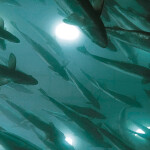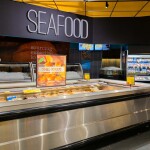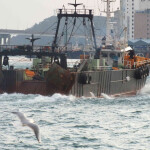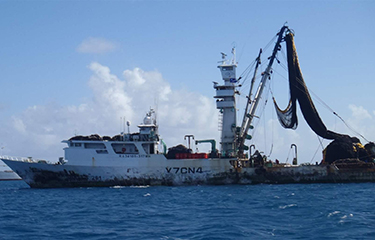The number of drifting fish aggregating devices (dFADs) in the Indian Ocean increased four-fold between 2007 and 2013, raising concerns on the harmful impacts the fishing gear has on marine fisheries.
Non-profit group Blue Marine Foundation (BMF), which has a mission of conducting ocean restoration by tackling overfishing, estimated the number of dFADs deployed globally in purse-seine tuna fisheries every year range from 81,000, to over 120,000. Some fisheries reporting an annual loss of more than 90 percent of their FADs, according to BMF.
“The use of dFADs is coming under increasing scrutiny for its effects on ecosystems, including high levels of bycatch of endangered, threatened and protected marine species, the harvesting of large volumes of juvenile fish, and the contribution to ocean pollution and the associated threats to sensitive coastal habitats,” BMF said.
A newly published list of minimum requirements for responsible dFAD use developed by the foundation has gained endorsements from Greenpeace, the International Pole and Line Foundation, the Zoological Society of London, and retailers such as Sainsbury’s, Whole Foods, Marks and Spencer, Migros, and Woolworths.
“There is a total lack of responsibility on the part of dFAD owners and operators for the impacts that their FADs have on ocean ecosystems,” BMF Head of Investigations Jess Rattle said.
Rattle said the decision by more than 100 global seafood stakeholders thus far backing the foundation's guidelines are supporting increased transparency in dFAD fisheries and strict adherence to the "polluter pays" principle.
“If these minimum requirements are not met, the only remaining course of action will be a complete moratorium on the use of drifting FADs,” she said.
However, thus far, regional fisheries management organizations have not taken significant measures to counter the abuse of dFADs. The Indian Ocean Tuna Commission recently failed to take a stand on proposals by some members to limit the use of dFADs in the Indian Ocean.
"Confusion surrounding voting protocols has meant that the measure has not formally been adopted, despite a two-thirds majority having been achieved," BMF Kenya Assistant Director of Fisheries Stephen Ndegwa said. “After decades of watching subsidized, foreign purse-seiners dominate tuna fisheries in the Western Indian Ocean, catching huge quantities of juvenile fish in the process, Kenya and other coastal states called for better FAD management at the June meeting of the IOTC but, despite receiving the necessary votes, our measure has still not formally been adopted."
Ndegwa called on the IOTC “to formalize the drifting FADs management measure as soon as possible to save our tropical tuna stocks from further decline.”
Greenpeace said the negative impacts of dFADs are obvious – yet industry pressure has consistently blocked effective action to curtail the use of the fishing gear.
“During the four months we spent in the Indian Ocean this year, we saw how dFADs deployed by European-owned fleets are changing the habitats of the western Indian Ocean at an unprecedented scale, and that urgent reform of dFAD fisheries is now needed,” Greenpeace Head of Oceans Will McCallum said.
An in-depth symposium held in May this year showcased how dFADs “can constitute illegal, unreported, and unregulated (IUU) fishing if they drift on an unauthorized basis into neighboring exclusive economic zones, marine protected areas, or other closed fishing sites.”
Retailers are beginning to take notice of the problems posed by dFADs, and are making sourcing decisions based on their use, according to Marks & Spencer Seafood Specialist Linda Wood.
“We take the sustainability of wild fish stocks and the health and livelihoods of coastal communities very seriously when sourcing our tuna,” Wood said. “It is very important that these minimum requirements for drifting FADs be adopted by all purse-seine fisheries to ensure that any tuna that reaches U.K. shelves comes from responsibly-managed fisheries.”
Blue Marine Foundation’s new guidelines offer recomended minimum requirements for responsible dFAD use. They were formally submitted to the IOTC Ad Hoc FAD Working Group on 4 October.
The International Seafood Sustainability Foundation, a nonprofit partnership among the tuna industry, scientists, and World Wide Fund for Nature, concluded that all tuna RFMOs “are making progress towards better FAD management by implementing the recommended best practices.”
The NGO has in a report cited several measures implemented variously by the RFMOs, such as the push for non-entangling FADs, capping the number of active FADs per vessel, and time and area prohibitions on FAD sets.
“Still, more needs to be done, in particular to set scientifically based limits that are commensurate with the productivity of the tuna stocks and to reduce FAD impacts on the ecosystem,” ISSF said in a press release.
Photo courtesy of The Pew Charitable Trusts







